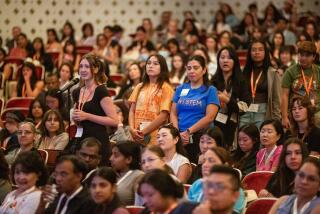Video Program to Spotlight Scientists
- Share via
Beginning in September, “Rendezvous With a Comet,” a new video program for high school and college students, will be available for rent and sale from the California Video Institute.
What is unique about the video is that it is the only program on comets to focus on women scientists. Martha Hanner and Marcia Neugebauer, comet scientists with the Jet Propulsion Laboratory, are featured in the two-tape set that covers the history of comet science and is also the first video program to show recent and future space missions to comets.
The nonprofit institute, based in San Fernando, was founded in 1981 for the purpose of encouraging women in scientific and technical fields by producing video programs that feature women role models and career counseling for women. “We’re the only group I know of using video technology in this specific area,” said founder Allison Nies.
Nies, 37, was a graduate student in physics in New York when a combination of events occurred. She had a summer job at NBC, happened to see a film made at Mills College about women mathematicians and attended a meeting of the American Physicists Society where she became indignant over a society report that said there was no discrimination against women in the field, a contention Nies calls “ridiculous.” She left school and decided to produce a video program about physics for women.
She came to Los Angeles, took a course in video production and raised the money, $1,500, from Los Angeles-area aerospace companies (“I wasn’t audacious enough to ask for more”) for her first production, “Women Physicists and Their Research.” The series of five video tapes is aimed at college-level students and features women in astronomy, solid state physics, medical physics, integrated optics and plasma physics. The physicists, taped in their laboratories around the country, discuss their education, mentors, and career stages, combining careers and family and their life styles as well as their scientific work.
“Some purists don’t like the films because they mix science with a personal profile,” she said. “But ‘Women in Physics’ is one of a kind. There’s nothing else out there like it. It uses a cinema verite technique. We followed them (the physicists) around. Not all students know what to make of it.”
What Nies said she has aimed for in her programs is to show the work and new developments in scientific fields and also the personal demands on scientists, such as travel and field work. “The philosophy is to be realistic. We show a very positive image, but don’t manufacture propaganda. Science is presented as something done by humans, not infallible experts.
“I’ve learned that there’s no prototypical personality for a woman scientist,” Nies said. “They contradict one another, don’t think alike, come from different backgrounds.”
The institute videos are available for rent or sale to schools, but not to individuals. Produced on a low budget for closed-circuit television in classrooms, they are not of broadcast quality and might be disappointing to viewers used to the slick production of commercial TV and videocassettes, Nies said. As film makers, “we are someplace between professional and amateur.” The content of the institute programs--what women scientists have to say about their work and lives--is enlivened by NASA film, which is in the public domain, and the new film on comets features new NASA computer animation of a spacecraft designed to fly alongside a comet.
In all, the institute, an all-volunteer operation, has now produced eight video programs. Among them are “Scientists in Space,” a film taped at Johnson Space Center about the roles of women who are NASA mission specialists, and “Voyager: The Inside Story,” a program of interviews with the women scientists and technical staff who worked on the Voyager I and II expeditions. “Working Under the Volcanos” was taped on location with five women volcano researchers including a vulcanologist, glaciologist and seismologist. The women describe their work, their attraction to the outdoor life and how they are achieving their career goals in the competitive field of earth sciences.
Among the institute’s volunteers are about 60 university and secondary science professors and teachers. For production, Nies uses student crews from film programs at local colleges. She has also researched her student audience. For the first four or five years of the institute’s existence, she supported herself with part-time jobs while working on the videotapes. Recently she became a substitute teacher and has an emergency credential to teach physics in the Los Angeles Unified School District, and she is working to obtain a full teaching credential.
The institute programs are available in VHS, Beta and 3/4-inch videocassette formats for rent and for sale. For a brochure write the California Video Institute, Box 7043, Mission Hills, Calif. 91346.
More to Read
Sign up for Essential California
The most important California stories and recommendations in your inbox every morning.
You may occasionally receive promotional content from the Los Angeles Times.










